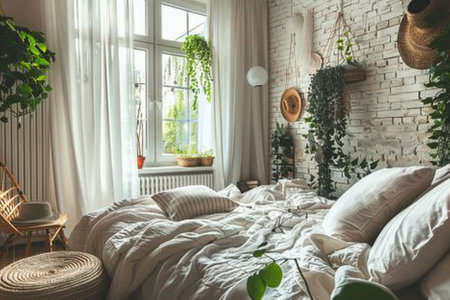Introduction to Bedroom Flooring
When it comes to creating a comfortable and inviting bedroom, flooring choices play a crucial yet often overlooked role. In the British context, where homes are designed to balance cosiness with practicality, selecting the right type of bedroom flooring can greatly influence both day-to-day comfort and long-term satisfaction. Whether it’s the warmth of a plush carpet underfoot during chilly mornings, the versatility of rugs in period homes, or the timeless appeal of hard flooring for easy upkeep, each option brings its own set of benefits and considerations. The choice of flooring not only impacts how a bedroom feels but also reflects broader aspects of British lifestyle, such as an appreciation for tradition, a need for thermal efficiency, and a preference for materials that stand up to the UK’s varied climate. Understanding these cultural and practical influences is essential when deciding on the best flooring solution to enhance bedroom comfort in British homes.
2. Carpets: The Quintessential British Choice
When considering the comfort and practicality of bedroom flooring, carpets stand out as the classic British favourite. Across the UK, wall-to-wall carpeting has long been regarded as a hallmark of homely interiors, particularly in bedrooms where warmth and cosiness are prized. This preference is deeply rooted in both tradition and the practical demands of Britain’s often chilly climate.
The Appeal of Carpets in UK Bedrooms
Carpets offer unmatched softness underfoot, creating a warm and inviting atmosphere that many Britons associate with relaxation and rest. Unlike hard flooring, which can feel cold during the winter months, carpets provide a layer of insulation that helps retain heat—an essential feature given the UK’s damp and variable weather.
Acoustic Benefits and Comfort
Another key advantage of carpets lies in their ability to absorb sound. In homes with multiple occupants or in terraced housing common throughout Britain, carpets help minimise noise transfer between rooms and floors. This results in quieter, more peaceful bedrooms that support restful sleep—a priority for many households.
Cultural Significance
The popularity of carpets also has cultural roots. For decades, British homes have favoured fitted carpets as a symbol of comfort and domestic pride. They’re seen not just as a practical solution but as a reflection of personal taste and attention to home maintenance.
Comparing Carpets to Other Flooring Options
| Feature | Carpets | Rugs | Hard Flooring |
|---|---|---|---|
| Warmth | Excellent insulation, retains heat | Moderate, depends on rug size/thickness | Poor without underlay or heating |
| Noise Reduction | High acoustic dampening | Partial (limited to covered area) | Low; amplifies footfall noise |
| Cultural Fit (UK) | Traditional favourite | Common accent piece | Modern but less traditional |
| Maintenance | Requires regular vacuuming; may stain easily | Easier to remove and clean | Sweeping/mopping required; scratches possible |
In summary, carpets remain the quintessential choice for British bedrooms due to their superior comfort, thermal properties, noise control, and cultural resonance. While newer trends may introduce alternatives such as hardwood or laminate, many UK homeowners still value the unique benefits that only wall-to-wall carpeting can deliver.

3. Rugs: Versatility and Style
Rugs offer a unique blend of comfort, versatility, and personal expression within the British bedroom. Unlike wall-to-wall carpeting or rigid hard flooring, rugs can be strategically placed to provide added warmth underfoot, especially during the colder months so common in the UK. Their insulating properties help retain heat in older British homes with draughty floorboards, making them a practical as well as aesthetic choice.
From a style perspective, rugs are an opportunity to introduce colour, pattern, and texture to a bedroom scheme. Popular British rug patterns often include traditional motifs such as tartans, florals inspired by the English countryside, or intricate geometric designs reminiscent of classic Wilton and Axminster weaves. These patterns not only reflect cultural heritage but also add visual interest without overwhelming the space.
In terms of usage, rugs in British bedrooms typically serve multiple functions. They are often placed beside the bed for a soft landing in the morning or layered over hardwood floors to break up large expanses and reduce noise—a consideration in many terraced or semi-detached homes. Maintenance is straightforward; regular vacuuming and occasional spot cleaning preserve both appearance and hygiene.
Ultimately, rugs enhance bedroom comfort by offering insulation and cushioning while allowing for seasonal updates or easy style changes. Their adaptability makes them a practical investment for those seeking both function and flair in their bedroom flooring choices.
4. Hard Flooring: Modernity Meets Practicality
In recent years, there has been a clear shift towards hard flooring options in UK bedrooms, with homeowners increasingly opting for wood, laminate, and vinyl over traditional carpeted surfaces. This trend is largely driven by the modern aesthetic appeal and practical benefits these materials offer. Hard flooring provides a sleek, contemporary look that complements minimalist and Scandinavian-inspired interiors, which are particularly popular across Britain.
Types of Hard Flooring Commonly Used
| Type | Appearance | Durability | Maintenance |
|---|---|---|---|
| Wood (Engineered or Solid) | Natural, warm tones; can be stained or painted | High, especially engineered varieties | Requires regular cleaning and occasional refinishing |
| Laminate | Mimics wood or stone; wide variety of finishes | Good resistance to scratches and fading | Easy to clean; minimal maintenance needed |
| Vinyl (LVT or Sheet) | Smooth or textured; variety of patterns including wood-effect | Highly durable and water-resistant | Simple upkeep; just sweeping and mopping required |
The Appeal of Durability and Longevity
The desire for durability is a leading reason why British homeowners are gravitating towards hard flooring. Unlike carpets, which can show wear and stains over time, hard surfaces stand up well to daily use. Wood floors, especially engineered options, cope admirably with the variable British climate—resisting warping in damp conditions. Laminate and vinyl are particularly well-suited for busy family homes or households with pets due to their scratch-resistance and resilience against spills.
Maintenance Advantages for UK Lifestyles
Hard flooring is far easier to keep clean compared to carpets. The British weather often means wet shoes and muddy footprints, but these can be swiftly wiped away from laminate or vinyl without leaving lasting marks. For allergy sufferers—a significant concern in many UK homes—the absence of fibres means less dust accumulation, contributing to better indoor air quality.
Summary Table: Pros and Cons of Hard Flooring in Bedrooms
| Pros | Cons |
|---|---|
| Modern aesthetic Durable under heavy use Low maintenance Allergy-friendly Wide range of design choices |
Can feel cold underfoot Less sound insulation Potentially slippery when wet May require area rugs for comfort and warmth Initial installation cost can be higher than carpet in some cases |
The move towards hard flooring in UK bedrooms clearly reflects a preference for practicality combined with a sophisticated look. With proper care and occasional maintenance—such as resealing wood or replacing worn-out sections of laminate or vinyl—these surfaces provide long-lasting comfort while meeting the demands of modern British living.
5. Comparing Comfort and Practicality
When it comes to selecting bedroom flooring in the UK, understanding the balance between comfort, maintenance, and practicality is essential. Each option—carpets, rugs, and hard flooring—offers distinct advantages and drawbacks that align differently with British household needs.
Comfort Considerations
Carpets are well-known for their underfoot warmth and softness, making them a popular choice for bedrooms, especially in colder British climates. They help insulate rooms and reduce noise transfer, contributing to a cosy atmosphere. Rugs, while not covering the entire floor, can be strategically placed to add comfort where needed—such as beside the bed—offering a similar soft sensation without fully committing to wall-to-wall coverage. Hard flooring, such as engineered wood or laminate, provides a sleek and modern look but tends to feel colder and less inviting unless paired with underfloor heating or layered with rugs.
Maintenance Demands
From a maintenance perspective, hard floors typically edge ahead. They are easier to sweep and mop, resisting stains and dust build-up—a practical benefit in busy households or for allergy sufferers. Carpets, on the other hand, require regular vacuuming and occasional deep cleaning to keep allergens and dirt at bay. Spills can quickly become permanent stains if not addressed promptly. Rugs offer flexibility: they can be shaken out, spot-cleaned, or even replaced more easily than fitted carpets if damaged or stained.
Practicality for British Homes
The unpredictable British weather means wet shoes and muddy pets are common challenges. Hard flooring is generally better suited for managing moisture and dirt ingress from outside. However, in bedrooms—which see less foot traffic—carpet remains a practical choice for its comfort. Rugs, meanwhile, allow for easy adaptation: they can be changed seasonally or moved around as tastes evolve or needs change.
Which Option Suits Your Needs?
The best choice ultimately depends on your lifestyle priorities. If warmth and softness are top concerns, particularly in upstairs bedrooms, carpet remains a strong contender. If low maintenance is key due to allergies or a busy family life, hard flooring supplemented with rugs may provide the ideal compromise—delivering both practicality and comfort tailored to British living conditions.
6. Choosing the Ideal Bedroom Flooring: Practical Tips
Selecting the right flooring for your bedroom is a decision that impacts both comfort and long-term satisfaction. In the UK, where weather can be damp and chilly, and sustainability is increasingly valued, a thoughtful approach is essential. Here are some actionable tips to guide you in making the best choice for your space.
Consider the Local Climate
British homes often contend with cooler temperatures and high humidity, especially in older properties. Carpets offer excellent thermal insulation, keeping bedrooms warm underfoot during colder months. If you prefer hard flooring, pairing it with thick, quality rugs will help retain heat and provide a cosy feel.
Prioritise Sustainability
Eco-friendly choices are becoming more accessible in the UK market. Opt for carpets made from natural fibres like wool, which is renewable and biodegradable. For hard floors, seek out FSC-certified wood or recycled materials. Rugs crafted from jute or sisal are also durable and environmentally sound options.
Assess Your Maintenance Preferences
If you want low-maintenance flooring, hardwood or laminate is easy to clean—just remember to use doormats to keep out mud typical of British weather. Modern stain-resistant carpets are practical for those who love softness but worry about spills.
Think About Allergies
For allergy sufferers, hard flooring such as engineered wood or vinyl is preferable as it doesn’t trap dust mites and pollen. If you love the warmth of carpet, consider hypoallergenic varieties and regular deep cleaning.
Reflect Personal Style
Your flooring should reflect your tastes while complementing your bedroom’s décor. Traditional British interiors often favour plush carpets in muted tones, while contemporary spaces may suit sleek wood or laminate paired with statement rugs. Don’t be afraid to mix textures for added interest.
Plan for Longevity
Invest in quality underlay for both carpets and hard flooring—it improves comfort and extends lifespan. Check warranties and aftercare advice from UK suppliers before committing.
Test Before You Buy
Always request samples to view in your own lighting conditions. Walk on them barefoot if possible, and consider how they’ll feel throughout the seasons. Taking these practical steps will ensure your bedroom flooring enhances comfort for years to come.
7. Conclusion: Creating a Cosy British Bedroom
In summary, the choice of flooring in your bedroom is more than a matter of style; it plays a significant role in both comfort and practicality, especially within the unique context of British homes. Carpets remain a traditional favourite, offering warmth underfoot during chilly mornings and contributing to the quiet, snug atmosphere many UK homeowners cherish. Rugs, meanwhile, provide an adaptable solution—layering extra softness over hard floors or injecting personality into neutral spaces while allowing for easy seasonal changes and maintenance. Hard flooring options such as engineered wood or luxury vinyl have grown in popularity due to their durability and ease of cleaning, making them suitable for those who prioritise low-maintenance living or contend with allergies. However, they may require additional accessories like underfloor heating or thick rugs to achieve that quintessentially cosy British feel.
Ultimately, your choice should reflect your lifestyle needs and personal taste while respecting the character of your property. Whether you opt for plush carpets to evoke a sense of classic comfort, practical hard flooring for modern convenience, or a blend using strategically placed rugs, each approach has its own impact on bedroom comfort. Considering local climate conditions and traditional preferences can help ensure your bedroom remains a welcoming retreat all year round—a true reflection of British home life.


